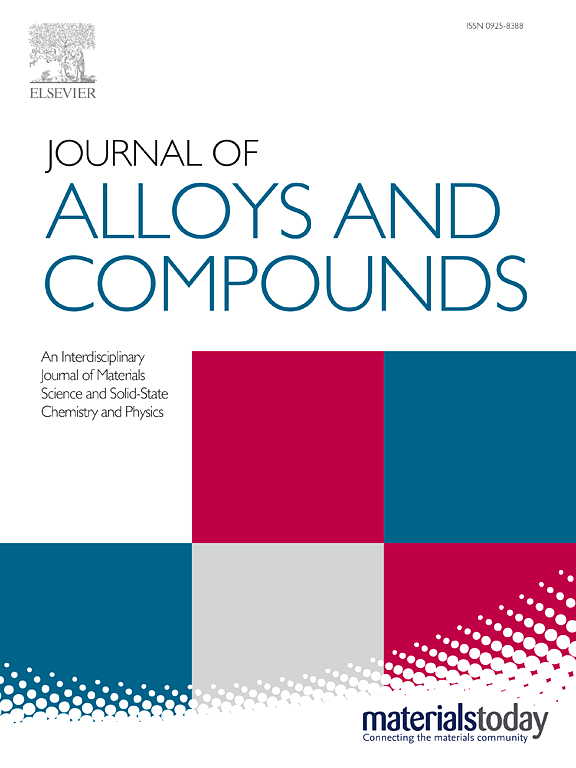Investigation into the correlation between composition, microstructure, and mechanical properties of Al-xFe-(6-x)Mn alloys
IF 5.8
2区 材料科学
Q2 CHEMISTRY, PHYSICAL
引用次数: 0
Abstract
The Al-Fe-Mn alloy system exhibits excellent thermal stability, making it a promising candidate for heat-resistant aluminum alloys. Nevertheless, systematic investigations into the influence of Fe/Mn ratio and cooling rate on the microstructural evolution and mechanical properties of Al-Fe-Mn alloys remain insufficient. In this work, Al-xFe-(6-x)Mn alloys prepared at two cooling rates were studied by tensile test, nanoindentation, TEM, etc. The results show that the co-addition of Mn and Fe can promote the transformation of coarse Al13Fe4 or lamellar Al6Mn phase to Al6(Fe, Mn) fibers. In addition, when the Fe/Mn ratio is 1, the matrix stacking fault energy is the lowest, and the Al/Al6(Fe, Mn) is coherent: (3 1 1)Al6(Fe, Mn)//(0 0 2)Al, (2 -2 1)Al6(Fe, Mn)//(-1 1 1)Al. The coherent interface generally enhances the thermal stability of the reinforcement phase due to the minimized interfacial energy. Nanoindentation results show that the hardness of the matrix and Al6(Fe, Mn) is the lowest when Fe/Mn is 1, among which the low hardness of the matrix is a reflection of the low stacking fault energy, while the hardness of Al6(Fe, Mn) is inversely proportional to the entropy value. High cooling rate can promote the transformation of skeleton-like Al6(Fe, Mn) into fibers of about 100 nm, greatly improving the mechanical properties of the alloy. The hardness of the chilled Al-4Fe-2Mn alloy is significantly higher than that of other alloys, reaching 115 HV. This work can provide important reference for improving the mechanical properties and heat resistance of heat-resistant alloys.

Al-xFe-(6-x)Mn合金成分、显微组织与力学性能的相关性研究
Al-Fe-Mn合金体系表现出优异的热稳定性,使其成为耐热铝合金的有希望的候选者。然而,系统地研究Fe/Mn比和冷却速率对Al-Fe-Mn合金组织演变和力学性能的影响还不够。本文采用拉伸试验、纳米压痕、透射电镜等方法对两种冷却速率下制备的Al-xFe-(6-x)Mn合金进行了研究。结果表明,Mn和Fe的共添加能促进粗Al13Fe4或片层Al6Mn相向Al6(Fe, Mn)纤维的转变。此外,当Fe/Mn比为1时,基体层错能最低,Al/Al6(Fe, Mn)相参为:(31 1)Al6(Fe, Mn)//(0 0 2)Al, (2 -2 1)Al6(Fe, Mn)//(-1 1)Al。由于界面能最小,相干界面通常增强相的热稳定性。纳米压痕结果表明,当Fe/Mn为1时,基体和Al6(Fe, Mn)的硬度最低,其中基体的硬度低反映了层错能低,而Al6(Fe, Mn)的硬度与熵值成反比。高冷却速率可促进骨架状Al6(Fe, Mn)转变为100 nm左右的纤维,大大提高合金的力学性能。冷却后的Al-4Fe-2Mn合金硬度明显高于其他合金,达到115 HV。该工作可为提高耐热合金的力学性能和耐热性提供重要参考。
本文章由计算机程序翻译,如有差异,请以英文原文为准。
求助全文
约1分钟内获得全文
求助全文
来源期刊

Journal of Alloys and Compounds
工程技术-材料科学:综合
CiteScore
11.10
自引率
14.50%
发文量
5146
审稿时长
67 days
期刊介绍:
The Journal of Alloys and Compounds is intended to serve as an international medium for the publication of work on solid materials comprising compounds as well as alloys. Its great strength lies in the diversity of discipline which it encompasses, drawing together results from materials science, solid-state chemistry and physics.
 求助内容:
求助内容: 应助结果提醒方式:
应助结果提醒方式:


